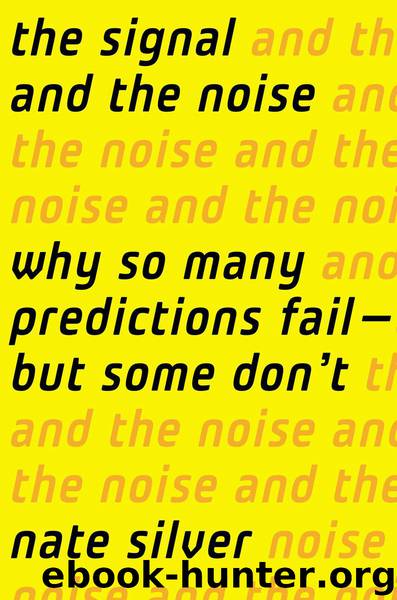The Signal and the Noise by Nate Silver

Author:Nate Silver
Language: eng
Format: mobi, epub
Publisher: Penguin Group, USA
Published: 2012-09-04T17:00:00+00:00
The other 94 percent of the time, the Lawyer starts out with a worse hand than ours. The problem is that there are five cards still left to come, and while it is relatively hard for them to improve our pair (we would need to catch one of the two remaining eights in the deck), he could more easily make a higher pair, straight, or flush.
The Lawyer takes a swig of coffee as the dealer arranges the flop cards on the center of the table. They consist of two clubs—a king and a three—along with the nine of hearts.
K 9 3
These cards have not improved our hand. Our hope is that they have not improved the Lawyer’s either, in which case our pair of eights will still be best. So we make a relatively modest bet of $35 into the $65 pot. The Lawyer pauses for a moment and calls.
This call is not great news for us, as we can see by further refining our estimate of his hand range. The key, following Bayes’s theorem, is to think in terms of conditional probabilities. For instance, if the Lawyer started with a hand like K J, now giving him a pair of kings, how likely is it that he’d call us again? (He’d almost certainly at least call having made top pair, but might he have raised instead?) What about if he began the hand with a smaller pair than ours, like 7 7—how likely is it that he’d call rather than fold? If we had the luxury of time, we could go through all 1,326 hand combinations individually and revise our estimates accordingly (figure 10-3).
Our actual estimates at the table will not be quite as precise as this. Still, we can come to some broad probabilistic characterizations of his hand range given his call. About 30 percent of the time, the Lawyer’s hand connected strongly with the flop and he has a pair of kings or better—a good hand that is unlikely to fold without a lot of pressure. There is also about a 20 percent chance that he has a pair worse than kings but better than our eights. These hands beat ours as well, but the Lawyer might be more likely to fold them later if we keep betting aggressively.
Meanwhile, there is about a 25 percent chance that the Lawyer has a draw to a straight or a flush, which is behind us for now but has many ways to improve. Finally, there is a 25 percent chance that he has a worse pair than ours or has almost nothing and is continuing in the hand solely in the hope of bluffing us later; these are the most favorable cases.
You can see how complicated poker decisions become. Some of these possibilities imply that we should continue to bet our hand as aggressively as possible. Others imply we should take a more cautious approach, while still others would mean we should be preparing to fold.
Just as we are contemplating this thorny decision, the dealer puts out the ideal card and makes our life easy.
Download
This site does not store any files on its server. We only index and link to content provided by other sites. Please contact the content providers to delete copyright contents if any and email us, we'll remove relevant links or contents immediately.
| Biomathematics | Differential Equations |
| Game Theory | Graph Theory |
| Linear Programming | Probability & Statistics |
| Statistics | Stochastic Modeling |
| Vector Analysis |
Weapons of Math Destruction by Cathy O'Neil(5034)
Factfulness: Ten Reasons We're Wrong About the World – and Why Things Are Better Than You Think by Hans Rosling(4020)
Factfulness_Ten Reasons We're Wrong About the World_and Why Things Are Better Than You Think by Hans Rosling(2753)
Descartes' Error by Antonio Damasio(2731)
A Mind For Numbers: How to Excel at Math and Science (Even If You Flunked Algebra) by Barbara Oakley(2691)
TCP IP by Todd Lammle(2637)
Applied Predictive Modeling by Max Kuhn & Kjell Johnson(2478)
Fooled by Randomness: The Hidden Role of Chance in Life and in the Markets by Nassim Nicholas Taleb(2412)
The Book of Numbers by Peter Bentley(2402)
The Tyranny of Metrics by Jerry Z. Muller(2401)
The Great Unknown by Marcus du Sautoy(2184)
Once Upon an Algorithm by Martin Erwig(2147)
Easy Algebra Step-by-Step by Sandra Luna McCune(2115)
Practical Guide To Principal Component Methods in R (Multivariate Analysis Book 2) by Alboukadel Kassambara(2092)
Lady Luck by Kristen Ashley(2070)
Police Exams Prep 2018-2019 by Kaplan Test Prep(2032)
Linear Time-Invariant Systems, Behaviors and Modules by Ulrich Oberst & Martin Scheicher & Ingrid Scheicher(1982)
All Things Reconsidered by Bill Thompson III(1960)
Secrets of Creation, Volume 1: The Mystery of the Prime Numbers by Watkins Matthew(1862)
